 |
| Category:
Colour patches |

|
|
|
|
|
|
AUSTRALIAN
ARMY MEDICAL CORPS 
|
Notes: (1) AAMC personnel attached to
non-medical units were directed to wear their respective divisional
AAMC colour patch.
Notes. (2) Horse transport details of divisional field ambulances were
AAMC personnel. Mechanical transport details of field ambulances were
members of the AASC(MT) and were attached from their respective
divisional supply column AASC. |
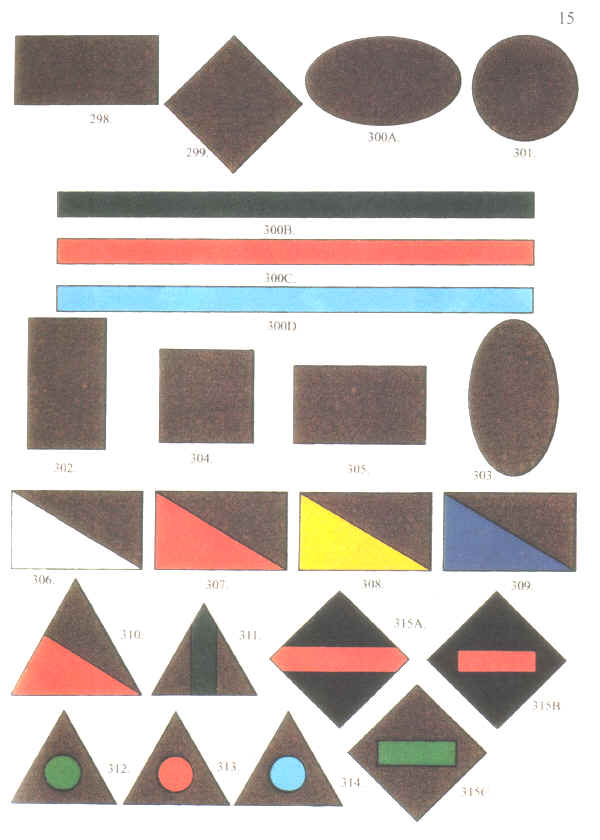 |
- 298. (a) AAMC 1st Aust.
Division, 1915 - 1918: Auth. I
Aust. Div. Order 562, 8.3.1915. 1st, 2nd, and 3rd Field
Ambulances.
- (b) 1st Aust.
Clearing Hospital, 1915; and
- 1st Aust.
Casualty Clearing Station, 1915- 1918:
Ref. 1st Aust. CCS memo dated 15.4.1917.
(AWM 11, item 1504/1/11)
- 299. (a) AAMC 2nd Aust.
Division, 1915 - 1919 : Auth. 2
Aust. Div. Inst., 3.8.1915. 5th, 6th, and 7th Field Ambulances.
- (b) 2nd Aust.
Casualty Clearing Station, 1915-1918:
Ref 2nd Aust. CCS memo dated 15.4.1917.(
ibid.)
- 300A. AAMC 3rd Aust.
Division, 1916 - 1919 : Auth.
Australian Imperial Force Order 231, 26.8.1916. 9th, 10th, and
11th Field Ambulances.
Note: Reference to the three following colour
patches first appears in a letter dated 31.5.1917 from the CO 10th
Aust. Field Ambulance to the CO 9th Aust. Field Ambulance, directing
that stretcher bearers of the latter unit were to attach a green band
on the left arm immediately above the brassard. The 10th and 11th
Field Ambulances were to wear red and light blue bands respectively.
(AWM 25, item 89/16.)
This information is further qualified by a HQ 3rd
Aust. Division memo dated 9.7.1917 advising that in recent operations
field ambulances of that division had worn a coloured strip, 9 inches
in length by 1/2 inch wide, attached three inches below the colour
patch, the strip being in the colour of the brigade to which each
field ambulance was attached. Permission was sought to continue this
practice however there is no record of it being granted.(16
AWM 11, item 1504/1/I 1.)
- 300B. 9th Aust. Field
Ambulance, 1917: Worn in conjunction with No. 300A.
- 300C. 10th Aust. Field
Ambulance, 1917: Worn in conjunction with No. 300A.
- 300D. 11th Aust. Field
Ambulance, 1917: Worn in conjunction with No. 300A.
- 301. AAMC 4th Aust.
Division, 1916 - 1919 : Auth. HQ
Aust and NZ Forces CM No. 17, 25.2.1916. 4th, 12th, and 13th Field
Ambulances.
- 302. AAMC 5th Aust.
Division, 1916 - 1919 : Auth. HQ
Aust and NZ Forces CM No. 17, 25.2.1916. 8th, 14th, and l5th Field
Ambulances.
- 303. AAMC 6th Aust.
Division, 1917 : Auth. AAG AlF
Letter No. 15/42, 25.5.1917.
- Only the 16th Aust. Field Ambulance was
raised for this formation in March 1917, being disbanded in
October 1917.
- 304. Aust. Base Depot
Medical Stores, 1918 - 1919:
Auth. Australian Imperial Force Order 1299, 16.7.1918. A 1 and 3/4
inch square.
- Referred to in Australian Imperial Force
Order .1299 as the Medical Section, Administrative
Headquarters, AlF, however the designation of the unit on
behalf of which authority was sought, and was specifically
approved for, is as shown.
- 305. AAMC 1st Aust.
Division, 1918 - 1919: Auth.
Australian Imperial Force Order 1051, 1.1.1918.
- 306. 1st Aust. Light
Horse Field Ambulance, 1916 - 1919 Auth.
Aust and NZ Mtd Div. RO No. 1, para. 4, 18.10.1916.
- 307. 2nd Aust. Light
Horse Field Ambulance, 1916 - 1919 Auth.
Aust. and NZ Mtd Div. RO No. 1, para. 4, 18.10.1916.
- 308. 3rd Aust. Light
Horse Field Ambulance, 1916 - 1919 Auth.
Aust and NZ Mtd Div. RO No. 1, para. 4, 18.10.1916.
- 309. 4th Aust. Light
Horse Field Ambulance, 1917 - 1919: Auth.
Australian Imperial Force Order 795, 10.8.1917.
- A previous 4th Aust. Light Horse Field
Ambulance was disbanded in July 1915, its personnel being used
as AAMC reinforcements.
- 310. 5th Aust. Light
Horse Field Ambulance, 1918 - 1919 : Auth.
Australian Imperial Force Order 1521, 21.1.1919.
- Formerly the Aust. Camel Field Ambulance.
- 311. Aust. Camel Field
Ambulance, 1918: Auth. Australian
Imperial Force Order 1051, 1.1.1918.
- Raised in June 1917 and redesignated the 5th
Aust. Light Horse Field Ambulance in July 1918.
- 312. 1st Aust. Casualty
Clearing Station, 1918 - 1919 : Auth.
Australian Imperial Force Order 1051, 1.1.1918.
- The unit advised that as at 30.10.1918 it had
still not received supplies of this patch and it is unlikely
that they were issued prior to mid December 1918.
- 313. 2nd Aust. Casualty
Clearing Station, 1918 - 1919: Auth.
Australian Imperial Force Order 1051, 1.1.1918.
- 314. 3rd Aust. Casualty
Clearing Station, 1918 - 1919: Auth.
Australian Imperial Force Order 1051, 1.1.1918.
- 315A. 1st Aust. General
Hospital, 1916:
- Reference is made to this patch by the CO 1st
AGH in a memo dated 26.6.1916. He stated that they were
procured in Egypt under a local purchase order, expenditure
being met by the AIF Ordnance Department, Cairo. The original
intention, as understood by the unit, was that these patches
were to be worn on the summer helmet, and not as a colour
patch on the tunic as they now were. (AWM 25, item 89/16.) It
was superseded by No. 315B, period unknown.
- 315B. 1st Aust. General
Hospital, 1916 - 1918:
- Ref, "Distinguishing Marks and Badges
AIF", undated, and AIF Admin. HQ Memo No. 26144,
31.10.1916. It would appear that No. 315A was issued in lieu
for a period, however 315B was in use by April 1917 as a
sample patch was submitted with a unit memo dated
28.4.1917.(AWM 11, item 1504/1 /11.) Superseded by No. 315C in
January 1918.
- 315C. 1st Aust. General
Hospital, 1918 - 1919: Auth.
Australian Imperial Force Order 1051, 1.1.1918.
|
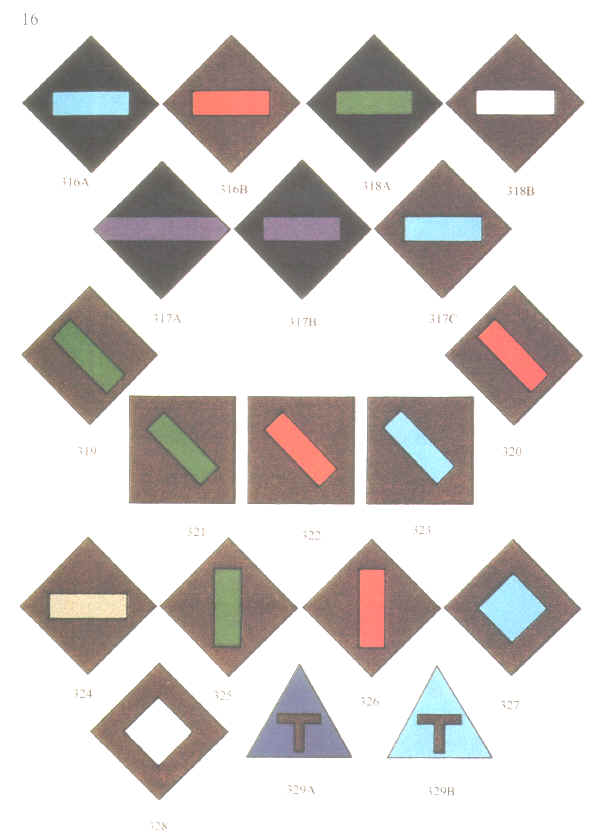 |
- 316A. 2nd Aust. General
Hospital, 1916 - 1918: Ref.
"Distinguishing Marks and Badges AIF", undated, and AIF
Admin. HQ Memo No. 26144, 31.10.1916.
- A sample of this patch was provided with a
2nd AGH memo dated 30.4.1917 with the advice that this was the
patch currently being worn by the unit. (ibid.) Superseded by
No. 316B in January 1918.
- 316B. 2nd Aust. General
Hospital, 1918 - 1919: Auth.
Australian Imperial Force Order 1051, 1.1.1918.
- 317A. 3rd Aust. General
Hospital:
- Sealed pattern held by Ordnance, a sketch of
which appears in AWM 25, Item No. 89/8. It has not been
possible to determine if this patch was actually worn.
- 317B. 3rd Aust. General
Hospital, 1916 - 1918: Ref.
"Distinguishing Marks and Badges AIF", undated, and AIF
Admin. HQ Memo No. 26144, 31.10.1916.
- This colour patch is stated as being worn by
a unit memo dated 26.4.1917.(ibid) Superseded by No. 317C in
January 1918.
- 317C. 3rd Aust. General
Hospital, 1918 - 1919: Auth.
Australian Imperial Force Order 1051, 1.1.1918.
- 318A. 14th Aust. General
Hospital, 1917 - 1918:
- No authority was ever given for this colour
patch however in early 1918 the CO 14th AGH advised HQ AIF
that it had been issued to his unit in November 1917 and he
was unable to obtain sufficient supplies of white material to
replace the green inset to conform to Australian Imperial
Force Order 1051.(ibid) This design had originally been
provisionally allotted to the l4th AGH as part of a scheme of
patches for the whole of the AAMC which had been considered
for approval in late 1917 and it would appear that its
approval had been anticipated by Aust. HQ, Egypt.
- 318B. 14th Aust. General
Hospital, 1918 - 1919: Auth.
Australian Imperial Force Order 1051, 1.1.1918.
- Note: No colour patches were authorised for
No's 4 to 13, 15 and 16 Aust. General Hospitals, which, with
the exception of the 10th A.L.H., served exclusively in
Australia.
- 319. 1st Aust.
Stationary Hospital, :
- Despite the appearance of this patch in
Volume III of the Official War History there is no evidence to
support its existence, In October 1916 this unit was
reorganized in England as the 3rd Aust. Auxiliary Hospital and
the CO of 3rd AMAH advised in April 1917 that no colour patch
had been allotted to the original unit. Personnel allotted to
3rd AMAH since its reorganization from 1st ASH were still
wearing the colour patches of their previous units at that
stage.(ibid)
- 320. 2nd Aust.
Stationary Hospital, 1918 - 1919: Auth.
Australian Imperial Force Order 1051, 1.1.1918.
- 321. 1st Aust. Auxiliary
Hospital, 1918 - 1919 : Auth.
Australian Imperial Force Order 1051, 1.1.1918.
- Raised at Harefield Park, Middlesex, in April
1915 as the Australian Convalescent Depot.
- 322. 2nd Aust. Auxiliary
Hospital, 1918 - 1919 Auth.
Australian Imperial Force Order 1051, 1.1.1918.
- Opened at Southall, Middlesex, in August
1916.
- 323. 3rd Aust. Auxiliary
Hospital, 1918 - 1919 Auth.
Australian Imperial Force Order 1051, 1.1.1918.
- Opened at Dartford, Kent, in October 1916 by
staff of the former 1st Aust. Stationary Hospital.
Note: No colour patches are known to have been
authorised for Nos. 4, 5 and 6 Auxiliary Hospitals serving in the
United Kingdom, or Nos. 7 to 28 Auxiliary Hospitals located in
Australia. The 1st to 4th Aust. Auxiliary Hospitals had also existed
in Egypt between 1915 and 1916 as offshoots of the 1st Australian
General Hospital.
- 324. 1st Aust.
Dermatological Hospital, 1916 - 1919: Auth.
Australian Imperial Force Order 1051, 1.1.1918. The first
reference to this colour patch is AIF Admin HQ Memo No. 26144,
31.10.1916, and the CO of 1st ADH advised on 13.4.1917 that the
patch was then in use by his
unit.(ibid) Raised
briefly in November 1915 as the Aust. Venereal Disease Hospital,
redesignated in December 1915.
- 325. No. 1 Aust.
Hospital Ship, 'Karoola'. 1918 - 1919 Auth.
Australian Imperial Force Order 1051, 1.1.1918. Raised in June
1915.
- 326. No. 2 Aust.
Hospital Ship, 'Kanowna', 1918 - 1919 Auth.
Australian Imperial Force Order 1051, 1.1.1918. Raised in June
1915.
- 327. No. 1 Sea Transport
Staff, AAMC: Ref Official War
History, Volume III. See note below.
- 328. No. 4 Sea Transport
Staff, AAMC: Ref. Official War
History, Volume III. See note below.
Note: The colour scheme of No's 327 and 328 would
suggest that they were intended to carry on from No. 326 although no
wartime correspondence appears to exist in relation to the matter.
Sketches exist in AWM 25, item No. 89/8, and they receive considerable
mention in correspondence between the Director of the AWM and the
Official Historian's staff during the early 1920's. Unfortunately this
is inconclusive, particularly in regard to the correct designations of
the units, and it appears that Dr Bean's staff have placed greater
weight on information received from the Department of Defence than
that of the Director AWM. (AWM 93, item 12/3/11.) It is likely that
the sea transport sections, in addition to providing medical personnel
for hospital transports returning to Australia, also manned Australian
hospital ships operating between France and England such as the
Wandilla, Warilda, and Western Australia.
- 329A. Sea Transport
Sections, AAMC: Auth. MO
396/1918, 24.8.1918. This authority was amended a month later by
MO 464/1918 and it has not been established whether in fact any
were manufactured or issued.
- 329B. Sea Transport
Sections, AAMC, 1918 - 1919: Auth.M0464/1918,28.9.1918.
|
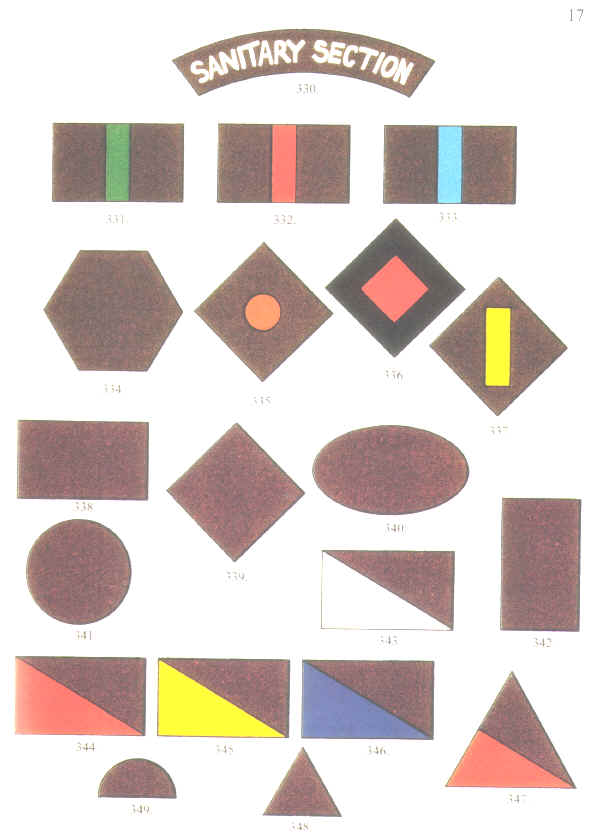 |
- 330. Sanitary Sections,
1916 - 1917: Auth. Australian
Imperial Force Order 396, 9.12.1916.
- To be worn above, and in addition to,
the colour patch. It is believed that the use of this title
probably lapsed after the approval in August 1917 for all
ranks of sanitary sections to wear a yellow armband on the
right arm with the letters 'SAN' in red, although reference to
the original authority was made in AIF Order No. 1051 of
1.1.1918.
- Note: Sanitary Sections of the 1st, 2nd, 4th,
and 5th Divisions were directed to wear the colour patch of
their respective divisional AAMC by HQ Aust and NZ Forces CM
No. 37, 11.3.1916. That for the 3rd Division Sanitary Section
was authorised by 3 Aust. Div. Instruction, para. 9, August
1916.
- 331. 6th Aust. Sanitary
Section, 1918 - 1919: Auth.
Australian Imperial Force Order 1051, 1.1.1918.
- 332. 7th Aust. Sanitary
Section, 1918 - 1919: Auth.
Australian Imperial Force Order 1051, 1.1.1918.
- 333. 8th Aust. Sanitary
Section, 1918 - 1919: Auth.
Australian Imperial Force Order 1051, 1.1.1918.
- 334. Dental Units, 1918
- 1919: Auth. Australian Imperial
Force Order 1051, 1.1.1918.
- Numbered from I to 118 and attached to
all field ambulances, light horse field ambulances, hospitals,
casualty clearing stations, training and reinforcement depots
and units, divisional headquarters, divisional ammunition
columns, detention barracks, and independent units. It is
possible that divisional dental units wore their divisional
AAMC patch until 1918.
- 335. Australian Army
Nursing Service, 1918 - 1919: Auth.
Australian Imperial Force Order 1306, 19.7.1918.
- To be worn by all members of the AANS except
those allotted to AAMC units for which a colour patch was
already authorised. This patch was principally to cater for
those nurses serving in the United Kingdom, and in British
stationary and general hospitals in France and Egypt.
- (Croydon War Hospital, as well as
Australian units, in the UK; No. 31 General Hospital in
Egypt; No's 5 and 38 Stationary Hospitals and No. 25
General Hospital in France.)
- 336. Aust. Army Nursing
Service, Salonika : No authority
located, shown in Vol. III of the Official War History.
Australian nurses were attached to four British hospitals during
this campaign.
- (No's 42, 50, 52 and 60 General Hospitals,
and briefly No. 66 General Hospital.)
- 337. Aust. Army Nursing
Service, India : No authority
located, shown in Vol. III of the Official War History.
Between 1916 and 1919 several hundred Australian nurses served in
hospitals in India, including the 34th (Welsh) and 44th General
Hospitals, RAMC, and on hospital ships operating between India and
various other theatres of war. The first batch of nurses for this
theatre was drawn from members of the AANS in Egypt, and it is
noted that they retained the colour patches of their previous
units. Remaining contingents of nurses were enlisted in Australia
for service in India.
Note: Nurses serving in India and Salonika were not
under the control of the DMS AIF, therefore it is unlikely any
authority for colour patches originated from HQ AIF, nor is there any
evidence that authority originated in Australia. A note appearing with
a sketch of No. 337 in AWM 25, item 89/8, states that it was approved
by the Imperial authorities in India.
- 338. 1st Aust. Mobile
Veterinary Section, 1916 - 1919 :
Auth. HQ Aust and NZ Forces CM No. 3 7, 11.3.1916.
- 339. 2nd Aust. Mobile
Veterinary Section, 1916 - 1919: Auth.
HQ Aust. and NZ Forces CM No. 3 7, 11.3.1916.
- 340. 3rd Aust. Mobile
Veterinary Section, 1916 - 1919 : 3rd
Aust. Div. Inst., para. 9, August 1916.
- 341. 4th Aust. Mobile
Veterinary Section, 1916 - 1919 Auth.
HQ Aust. and NZ Forces CM No. 3 7, 11.3.1916.
- 342. 5th Aust. Mobile
Veterinary Section, 1916 - 1919 Auth.
HQ Aust. and NZ Forces CM No. 37, 11.3.1916.
- 343. 6th Aust. Mobile
Veterinary Section, 1916 - 1919 Auth.
Aust. and NZ Mtd. Div. RO No. 1, 18.10.1916.
- 344. 7th Aust. Mobile
Veterinary Section, 1916 - 1919 Auth.
Aust. and NZ Mtd. Div. RO No. 1, 18.10.1916.
- 345. 8th Aust. Mobile
Veterinary Section, 1916 - 1919 :
Auth. Aust. and NZ Mtd. Div. RO No. 1, 18.10.1916.
- 346. 9th Aust. Mobile
Veterinary Section, 1917 - 1919: Auth.
Australian Imperial Force Order 795, 10.8.1917.
- 347. 10th Aust. Mobile
Veterinary Section, 1918 - 1919: Auth.
Australian Imperial Force Order 1521, 21.1.1919.
- 348. Aust. Veterinary
Hospital, Calais, 1917 - 1919: Auth.
Australian Imperial Force Order 654, 22.5.1917.
- Note that the dimensions authorised for this
colour patch are for a I and 1/2 inch equilateral triangle.
- 349. 1st Aust.
Veterinary Evacuating Station, 1918 - 1919: Auth.
Australian Imperial Force Order 1277, 28.6.1918.
- Note that the dimensions authorised are for a
I and 1/2 inch base, with 3/4 inch radius. Raised in June
1918.
|
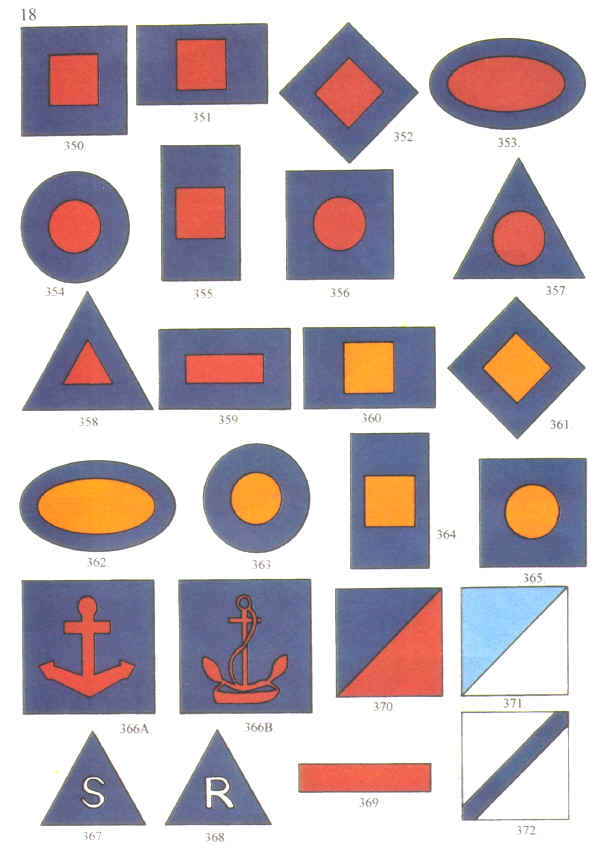 |
- 350. AAOC 1st Aust.
Division, 1916 - 1917: Auth.
Australian Imperial Force Order 143, 11.5.1916.
- Superseded by No. 351 in May 1917. No actual
ordnance units existed in the divisional organization,
armourers, artificers, etc, of the AAOC being attached by War
Establishment to units of other arms.
- 351. AAOC 1st Aust.
Division, 1917 - 1919: Auth.
Australian Imperial Force Order 644,15.5.1917.
- 352. AAOC 2nd Aust.
Division, 1916 - 1919: Auth.
Australian Imperial Force Order 143, 11.5.1916.
- 353. AAOC 3rd Aust.
Division, 1916 - 1919: Auth. AIF
Admin. HQ Memo No. 26144, 31.10.1916.
- 354. AAOC 4th Aust.
Division, 1916 - 1919: Auth.
Australian Imperial Force Order 143, 11.5.1916.
- 355. AAOC 5th Aust.
Division, 1916 - 1919: Auth.
Australian Imperial Force Order 143, 11.5.1916.
- 356. AAOC,
Non-Divisional Units, 1918 - 1919 : Auth.
Australian Imperial Force Order 113 3, 1.3.1918.
- Includes the 1st and 2nd Aust. Ammunition
Units, as well as AAOC personnel serving with headquarters,
various types of ordnance workshops, and other units of the
AOC.
- 357. Ordnance Company -
I.O.M. Section, 1918: Example,
Military Heraldry Collection AWM. A sketch also appears in AWM 25
Item No. 89/8.
- Organized in Australia by the Inspector of
Ordnance Machinery (I.O.M.) Branch and despatched overseas in
January 1918. On 19.11.1918, Australian Imperial Force Order
1445 advised that it had been reorganized as the 1st Aust.
Ordnance Mobile Workshop (Medium), and the 2nd and 3rd Aust.
Ordnance Mobile Workshops (Light). No authority relating to
this colour patch has been located.
- 358. Army Ordnance
Corps, Rouen - Australian Section: A
coloured sketch of this colour patch was located in a contemporary
diary maintained by a member of the Aust. Siege Brigade, and
currently held by the Royal Australian Artillery Historical
Society of Western Australia. The diary states that it was
proposed and no official reference to its use has been located.
- 359. Aust. Army Ordnance
Corps (Egypt), 1919: Auth. AAG,
AIF in Egypt, Letter No. 6/48,16.1.1919.(AWM 25, item
89/16.)
- Personnel appointed as Chemical Advisers and Gas
Officers on the headquarters of formations, or as instructors at
gas schools, etc, continued to wear the colour patch of their
formation headquarters or of the unit to which they had previously
belonged.
- Divisional Gas Officers and NCOs, and instructors
at Divisional Gas Schools wore a green over
black armband.
- 360. AAPC 1st Aust.
Division, 1918 - 1919: Auth.
Australian Imperial Force Order 1332, 28.7.1918.
- 361. AAPC 2nd Aust.
Division, 1918 - 1919: Auth.
Australian Imperial Force Order 1332, 28.7.1918.
- 362. AAPC 3rd Aust.
Division, 1918 - 1919: Auth.
Australian Imperial Force Order 1332,28.7.1918.
- 363. AAPC 4th Aust.
Division, 1918 - 1919: Auth.
Australian Imperial Force Order 1332, 28.7.1918.
- 364. AAPC 5th Aust.
Division, 1918 - 1919: Auth.
Australian Imperial Force Order 1332,28.7.1918.
- 365. AAPC
(Non-divisional Personnel), 1918 - 1919 : Auth.
Australian Imperial Force Order 1332, 28.7.1918.
- Initially approved on 10.7.1918 for all AAPC
personnel regardless of formation affiliation but revised on
28.7.1918 for personnel in non-divisional postings only. These
included pay staffs in Bombay and South Africa in addition to
those in Egypt, France and the United Kingdom.
- Initially raised in 1914 as
a Post Office Corps, forming field post offices for HQ 1st Aust.
Division, 1st Aust. Division Train, and brigade headquarters.
Formation of a Base Post Office was approved in late 1915. In
March 1916 all postal units of the AIF were directed to form part
of the Australian Army Postal Corps, (Australian Imperial
Force Order 107, 8.3.1916.) although
personnel serving as unit postal orderlies were not affected by
this reorganization. Unit postal orderlies were transferred to the
Army Postal Corps in December 1917 and August 1918.
(Australian Imperial Force Order 1009, 7.12.1917, and Australian
Imperial Force Order 1324, 30.7.1918.)
- No distinctive colour
patches were approved for this Corps, members wearing the colour
patch of the formation headquarters to which the respective units
were attached. (HQ 1st Aust. Corps Memo No. 1527,
26.6.1940. AA(Vic): MP 508/1, item 36/756/25.)
In 1916 personnel employed in Base, Army, and Field Post Offices
were authorised to wear a four inch
wide armlet on both arms, equally divided white over red.(Australian
Imperial Force Order 61, 18.1.1916)
Originally raised in 1914 as a
Military Mounted Police although no formed units existed at that
stage. Subsequently reorganized in March 1916 as the Anzac Provost
Corps, (Australian Imperial Force Order 107, 8.3.1916.) and
was redesignated the Australian Provost Corps on 1. 1. 1918.
(Australian Imperial Force Order 1058, 8.1.1918.)
| No
distinctive colour patches were approved for this Corps,
personnel posted to the establishment of formations wearing
the colour patch of their formation headquarters. |
| In February 1917,
Australian Imperial Force Order 496 directed members of the
Corps to wear a blue hat band and the metal shoulder title
'ANZAC/PROVOST CORPS'.
Personnel serving on the BEF
lines of communication were directed to wear a red hat band,
in lieu of the blue previously authorised, by Australian
Imperial Force Order 719.
|
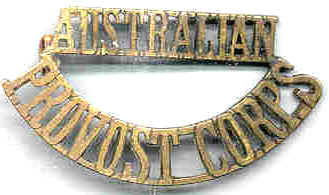 |
| Following
the redesignation of the Corps in January 1918, Australian
Imperial Force Order 1097 approved a change in the metal
shoulder title to 'AUSTRALIAN PROVOST CORPS'. |
Divisional
Traffic Control Detachments, 1916
- 1918: In March 1918, 'A' Class
personnel of these units were replaced by medically downgraded '13 V
Class men, and traffic control detachments subsequently became part of
the divisional detachments of the Australian Employment Company. It is
believed that they retained the colour patch of their respective
divisional headquarters. Although referred to by C. E. W. Bean as
'police', they were not actually part of the Provost Corps.
-
366A. Royal
Australian Naval Bridging Train, 1916 - 1917: Ref.
"Distinguishing Marks and Badges AIF", undated, and AIF
Admin. HQ Memo No. 26144, 31.10.1916.
-
This particular
design of anchor appears on an example held in the Military
Heraldry Collection AWM. The original reference however shows
a dreadnought anchor, i.e.. comprising a stockless shank with
a heavy base and flukes rising up from this base. To
complicate matters Mr. P.R. Wightman of the Official
Historian's staff advised the Director of the AWM during the
early 1920's of correspondence on the matter that he had
undertaken with Lieutenant-Commander Bracegirdle, OC RANBT, in
which Bracegirdle stated that the design of anchor worn by his
unit did not have a heavy base and was stockless, i.e.. no
upper crossbar. (see note 76) This is the design depicted in
Volume III of the Official War History. Dimensions of this
patch as approved in the quoted references are 2 and 1/2
inches square.
-
Note
76. AWM 93, item 12/3/11. Unfortunately a
correspondence file held by the AWM which relates to the
original proposals for this badge, and contains samples of
proposed designs, could not be located during a visit by
the author in September 1996.
-
366B. Royal
Australian Naval Bridging Train: Example,
Military Heraldry Collection AWM.
-
Chain
stitch embroidery, possibly of Middle East manufacture. The
RAN Bridging Train was raised on 24.2.1915 as a unit of the
AIF from personnel of the RAN and RANR, and was disbanded on
31.3.1917. A large number of its personnel subsequently formed
the 17th Field Company AE.
-
367. Special
Duty Personnel, 1918 - 1919: Auth. MO 210/1918,
25.5.1918.
-
Approved for
officers and men of the AIF who were not already entitled to
wear a colour patch, and were gazetted for special duty, i.e..
conducting drafts of Yugoslav and Italian contingents, etc. A
2 inch equilateral triangle, lettering 5/8ths inch high.
-
368. General
Service Reinforcements, 1919 - 1920 : Auth. MO
104/1919, 1.3.1919.
-
Allocated
to officers and men of the AIF who left Australia, but
returned without having been posted to a unit. A 2 inch
equilateral triangle, lettering 5/8ths, inch high. It should
be noted that this patch was only for personnel who had left
Australia. Other woven cloth badges, outside the scope of this
book, were approved for discharged returned soldiers, recruits
who were demobilised at the end of the war without leaving
Australia, and serving personnel who volunteered for the AlF
but were not accepted either because they were medically
unfit, or the nature of their duties required them to
be retained for Home Service.
-
369. AIF
Graves Detachment, 1919: Ref, Staff Officer AASC(MT)
memo dated 7.6.1919.
-
This patch is
stated to have already been in use at the time of writing and
was being worn below their original unit colour patch by all
personnel posted to this unit on demobilisation of their own
units. Reference to it also appears in the contemporary diary
held by the RAAHS of WA, where it is depicted worn under the
patch of HQ Australian Corps.
-
Divisional
Salvage Companies, 1917 - 1919: Units
wore the colour patch of their respective divisional headquarters
with, in addition, a khaki arm band I
and 1/2 inches wide bearing the word 'SALVAGE' in red letters.
-
Australian
Employment Company, 1917 - 1918: Raised
on 1st November 1917 from medically downgraded 'B' Class
personnel, comprising one corps and five divisional detachments.
This unit, with an establishment of over 500 all ranks by mid
1918, provided the sanitary personnel, batmen, orderlies, mess
men, and cooks for the various formation headquarters,
boot-makers, barbers, theatre and cinema operators, bath and
laundry detachments, traffic control detachments, general duty-men
for ordnance duties, and YMCA and Church Army representatives.
These personnel wore the colour patch of the formation
headquarters to which their detachment was allotted, or retained
the colour patch of their previous unit.
-
Miscellaneous
Units: These included the
-
1st Aust.
Convalescent Depot,
-
field
punishment compounds,
-
Aust. Corps
Entrenching Battalion,
-
training
schools or units, and
-
reinforcement
units and depots.
Note: The three following colour
patches first appeared on a Department of Defence colour chart issued
in July 1918, which showed colour patches approved for the AIF up
until about March 1918. They were then included in the colour chart
forming part of Volume III of the Official War History, although this
reference shows them as cancelled colour patches. It is this writer's
opinion that none of these patches in fact existed and that confusion
has resulted from the original drawings published in Anzac Mounted
Division Routine Orders and AIF Orders, which on first examination
could be mistaken as squares. However in all cases the dimensions are
clearly stated as 2 and 1/2 inches high by I and 1/2 inches wide, and
all period examples held by the AWM conform to this size.
-
370. 1st
Field Squadron, A.E.: Although
the Official War History depicts this patch with white in place of
the dark blue this is most likely the result of a printing error.
-
371. 1st
Signal Squadron, A.E.:
-
372. AASC
Aust. and N.Z. Mounted Division:
|
|
The
material on this section of the site is drawn from "Distinguishing
Colour Patches of the Australian Military Forces 1915-1951" by
Keith Glyde. ISBN 0-6460-36640-8 |
|